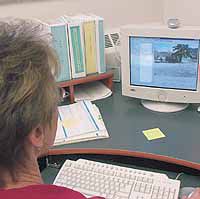| Carbon Assessor Nancy Ferderber demonstrates the pictures of private residences and related information contained in the property re-valuation program designed specifically for the county office. |
Carbon County Assessor Nancy Ferderber and the office staff have a responsibility many people take issue with. The job is to assess properties in the county for tax evaluations.
By Utah state law, the county assessor’s office must reassess property every five years.
But for many of the rural counties in the state, staffing is such that the offices cannot meet the designated schedule.
“The tax commission has worked with us closely on this,” explains Ferderber. “They understand that we can’t always get it done.”
“But with the new computer data base that has been developed and with the help of the county’s geographical information department, we have been able to start a reassessment this past year and will continue to work on it,” adds the assessor.
Since the tax notices went out last year, the assessor’s department has been able to canvas about 2,000 residences and personal pieces of property that exist in the unincorporated areas of northern Carbon County and in Carbonville.
“We decided to divide the county up into divisions,” indicates Ferderber. “We started with those two divisions and, next year ,we hope to complete the rest of the unincorporated areas or what we refer to as the water district areas or those areas served by PRWID.”
After the county assessor’s office completes the valuations in the two divisions, the property reassessments will start on the incorporated areas in the county, beginning with Price city.
“There are many areas in the county that have not been reassessed since the 1970s,” states Ferderber. “The most important thing we strive for in all of this is uniformity in value.”
Sometimes local residents come before the board of equalization after preliminary evaluation notices have gone out to complain about taxes, points out Ferderber. The board of equalization is usually scheduled to meet in late summer.
Residents should not present questions regarding taxes to the board, but should appear to bring up problems with the way private properties are evaluated.
“Appeals must be based on value. For instance, is there a mistake in the data we have used to evaluate the property or if someone is concerned that their house will not sell for the amount we have valued it,” notes the assessor.
The situation brings up the issue of just how the county assessor’s office values property.
“We base the reassessment on a physical inspection of each property,” explains Ferderber. “This past year, we have gone to everyone of the reassessed sites and based our values on that.”
Sometimes residents have issues about how a property is assessed because they never saw or spoke to anyone from the county assessor’s office, indicates Ferderber.
But the staff members at the assessor’s office frequently go out during the day, when most people are not at home, to complete the valuations.
“If we had to talk to every homeowner, it would take us too long,” comments Ferderber. “What we are doing is a mass site evaluation. We do some measuring, look at the size of the home the property and assign it a value based on similar values.”
The county assessor’s office had four people working on the new site assessments. The office will have a similar number of workers next year when the county focus on completing the Price River Water Improvement District section of the reassessments.
The assessor’s office staff have to work quickly, but be accurate and visit every property in the area.
In the event a resident suspects a home was not visited during a reassessment, the proof is contained on the computer data base. Each file contains a photo of the property or home.
To demonstrate the data base, Ferderber brought up two properties within seconds and, on the computer screen, were displayed the images of the structures in question.
“This is the way we built the program – just for Carbon County,” explains the assessor. “The system still has a few bugs, but only a few.”
Ferderber pulled up a picture plat of a neighborhood to show how the county office could view the various properties and parcels.
Most of the parcels were identified by a name, but one section included on the plat had the word “unknown” printed on it.
“That concerns me when I see that,” pointed out the assessor “That means no one knows who owns that property and that means the county is not collecting taxes on it as they should.”
It is more important than ever for local residents to understand the reassessment process, according to the county assessor.
“Not only were some of the values in the north county area and Carbonville increased, but the voted leeway tax for the school district that voters passed in February will also kick in on these tax notices,” she noted.
The projections during the election by the school district is that the new leeway would increase a $100,000 home’s taxes by about $60 per year. With higher assessments on some county properties that means taxes will go even higher for those people.
“We sent letters out last month about the reassessments and soon the preliminary tax notices will go out. People often ask me how much a reassessment we have done will cost them, but we don’t compute the taxes, we just consider the evaluations. That part is up to the county treasurers office,” concluded Ferderber.

